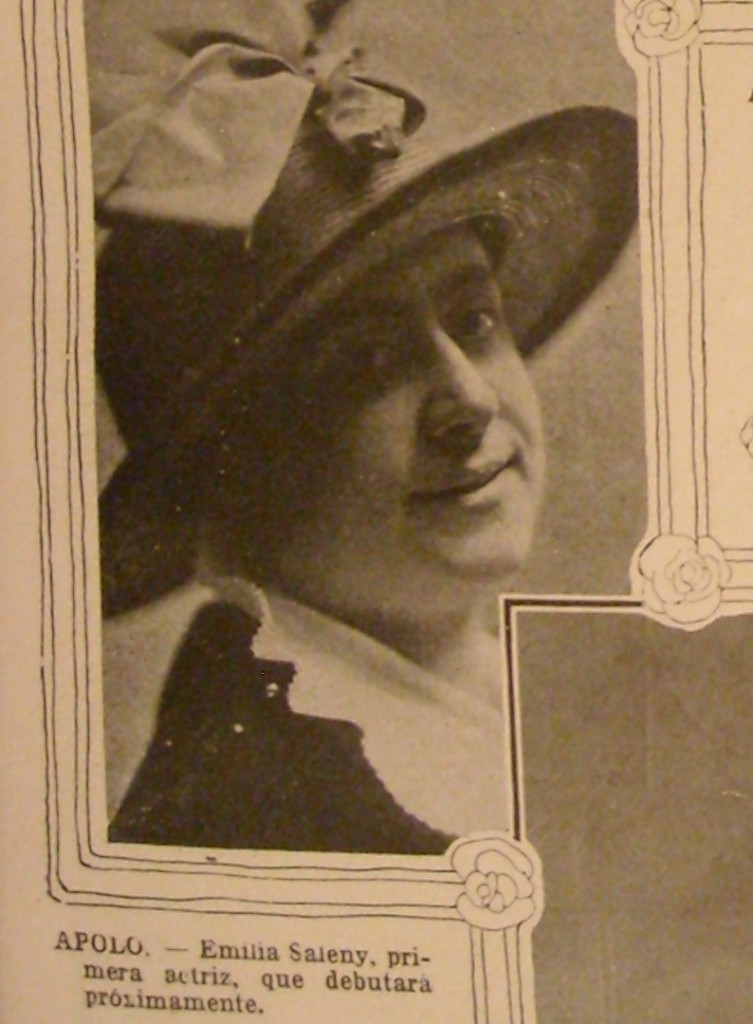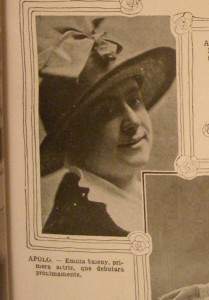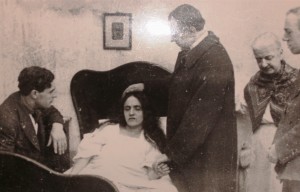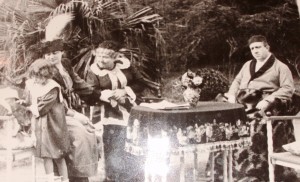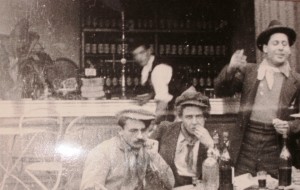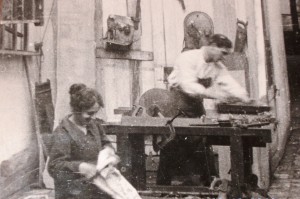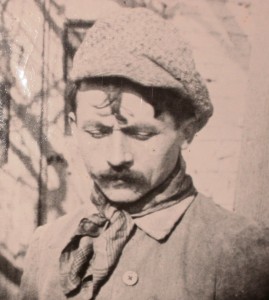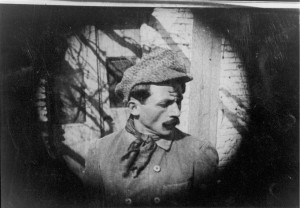Among all the pioneers linked to the birth of cinema in Argentina was the young woman of Italian origins who was to become, as far as we know at the moment, not only the first Argentine woman filmmaker, but also the filmmaker of the first Argentine children’s movie and the first woman to found an academy for film actors in South America: Emilia Saleny. Few records are available for us to piece together her life. Her death certificate, found in the Registro Nacional de las Personas (National Register of Persons in Buenos Aires), states that she died on August 22, 1978 at her home, Calle Caseros 574, the widow of Alberto Olivero, and the daughter of Antonio Saleny and Victoria Pieri. Her nephew José Di Leo declared her death. The certificate indicates that she was an Argentine citizen and her birth date appears as June 26, 1894. The scant critical essays that have remembered her name seldom include biographic details, and those that do, offer inconclusive speculations. Theater historian Beatriz Seibel follows Jacobo De Diego’s assumption that Emilia was born in 1891 in Buenos Aires (Seibel 2002, 529); historian Héctor Kohen wonders whether she was born in Italy and arrived in Buenos Aires already as a professional actress (Kohen 1994, 34); and film critic Paraná Sendrós asserts in a newspaper article that her origins were Italian and that the original spelling of her name was “Salegni” (n.p.). Several announcements between 1917 and 1919 in the most important newspaper of the Italian community in Buenos Aires at the time, La Patria degli Italiani (1876-1931), indicate that she was an active member of the Italian community settling in the city at the beginning of the century. On June 23, 1917, la “Signora” Emilia Saleny appears as a “valorosa artista” (“valiant artist”) in the newspaper’s announcements concerning her film career (“La Niña del bosque” 4). An announcement in La Patria from October 16, 1917 even suggests that her birthday might have been on October 16, instead of June 26 (4). According to an announcement in La Patria on May 5 of the same year, her mother, Vittoria, had been a renowned actress in Italy (4). However, Seibel, following the information found in De Diego’s 1973 unpublished Diccionario Teatral (Theater Dictionary/Patrimony of the Fondo Nacional de las Artes), indicates that it was Emilia’s aunt and uncle who were respected Italian actors, and that Emilia would have traveled to Italy in 1910 to train as an actress, working successfully there between 1910 and 1914 in the theater and returning to Buenos Aires in 1914 at the outbreak of World War I (529). On first examination, study of the passenger records of Italian ships entering or exiting the port of Buenos Aires in those years yields no surname that comes close to that of Emilia’s. Neither the spelling “Saleny” (or “Salegni”) is Italian, nor is a name by that spelling listed in genealogical research tools or registered in any Italian ship record—that is, until 1924.
By 1924, when Emilia’s last name appears as “Saleny” on ship records, she had made four films, and perhaps as many as five. Nonetheless, matching the year of birth on Emilia’s death certificate we find a record on the ship Garibaldi arriving on July 29, 1915 in Buenos Aires from Genoa. It was a ship that offered only 25 first-class bookings out of a total of 1,625. Among the Italian first-class passengers there were two women, both registered as theater actresses: Vittoria Pieri Salani, a fifty-year-old widow; and Emilia Pieri Salani, a twenty-year-old single woman, both listing their nationality as Italian. To judge by at least one other immigration record, her trips to Italy may have been frequent. Almost ten years later, on October 20, 1924, Emilia disembarked in Buenos Aires, having sailed from Genoa on the ship Nazario Sauro, and here on the 1924 voyage where her last name is finally spelled “Saleny” we learn that her profession is still “actress” but her nationality is now Argentine, her age is thirty and her marital status is “widow.” We can deduce the last name of her first husband from the several announcements about her films in La Patria, where she appears as “Emilia Saleny in Ferrari.” But according to her death certificate, her husband’s last name was Olivero. Thus we are to assume that she was twice a widow.
Saleny belonged to the vibrant Italian community that was rapidly increasing in turn of the century Buenos Aires. The city of Buenos Aires during this period was undoubtedly home to a good number of women dedicated to public culture. However, if they were not involved in the cultural front of the anarchist or feminist movements of the period they tended to be women of high society who, with a few exceptions, educated “decent” señoritas in cultural workshops, teaching the piano or singing classes, or hosted charitable cultural events in ladies clubs. A perusal of the main newspapers – La Nación or La Prensa – or those within the Italian community itself, such as La Patria, shows us that film production, distribution and exhibition were heavily enlisted for charitable purposes.
Saleny must have moved among educated, artistic, and wealthy circles of the city because she traveled first class. However, while we do not have information about her membership in any political group of the time, we may assume that she did not dedicate much of her time to charities. She not only acted and filmed but also founded what was most likely the first Academia de Artes Cinematográficas on the continent, just months after disembarking from the Garibaldi in 1915 when she was probably only twenty years old.
On November 6, 1915, the magazine Caras y Caretas announced her debut as a lead actress at the Apolo theater (n.p.). In 1916, filming had begun at the Academia, and on July 3, 1917 La Patria announced the premiere of her first film, La niña del bosque/The Girl of the Forest (4). Considering the 1917 announcement of her as “Emilia Saleny in Ferrari,” she appears to have married right at the beginning of her filmmaking career. In 1916 she also acted in El evadido de Ushuaia/The fugitive of Ushuaia, a mystery film written by the Marquis Enzo D’Armensano which premiered on December 27, 1916 at the Cine Callao. El evadido de Ushuaia was produced by Condor Films and Saleny’s co-stars were Luis Ramassotto and Pepita Muñoz. Also in 1916, Saleny acted in América by Federico Mertens, together with the famous actor Roberto Caseaux. In 1917 she acted in Problemas del corazón/Problems of the Heart, apparently also produced by Condor Films, “an improvised studio at 1600 Sarmiento Street” (Foppa 1961, 951).
We may imagine that Emilia made the transition from actress to instructor on her (probable) October 16 birthday in 1915. Two years later, on October 16, 1917 La Patria announced the anniversary of the Academy of “declamation, recitation, and cinematographic art,” celebrating its third year of operation (and its 50 students) in its location at Cangallo Street 1636, as well as “signora Saleny’s” birthday (4). In 1917, the film magazine La Película reports on the opening of the academy at another location in Belgrano. Here, Saleny’s Academy is described as the most serious and trustworthy of all the academies in Buenos Aires, and is compared to other academies that would take advantage of young people aspiring to become actors. According to Seibel, who follows De Diego, a fire would destroy all of Emilia’s films and she subsequently returned to theater acting, touring Argentina and Brazil as well as working in radio with her own scripts (529). On July 30, 1920, La Nación announced the premiere at the theater Círculo Católico de Obreros of the comedy Cantos rodados/Boulders by Francisco Imhoff, in which “Señorita” Emilia Saleny was the actress (n.p.).
We know as little of Emilia Saleny as a filmmaker as we do of her life. She directed the films La niña del bosque (1917), Paseo Trágico/Tragic Promenade (1917) and El pañuelo de Clarita/Clarita’s Kerchief (1919). If we trust the aforementioned birthday announcement for the Academy in La Patria there was another film, Delfina, also from 1917, which Seibel and De Diego credit to her. However, the newspaper’s announcement is unclear as to whether this film was actually directed by students. The latter would have been the same students that apparently filmed Luchas en la vida/Life Struggles (1919). Yet film historians who mention Saleny have thus far recorded her film career differently, and there is wide disagreement among them. According to four of these historians, she directed only two films (Paranaguá 129; Couselo 34; Trelles Plazaola 9; Núbila 28). A fifth, Jorge Finkielman, mentions two films, spells Emilia’s last name “Salemy” and states that there were only child actors in El Pañuelo de Clarita (21). Others credit her with more than two films but do not concur as to her role. According to Héctor Kohen, Emilia Saleny acted in at least one film, directed three, and “enabled the making of another” (34). César Maranghello lists three films yet confuses El Pañuelo de Clarita with Paseo Trágico (35). Calvo thinks Saleny directed four films with her students, but all are now lost, and Seibel concurs (Seibel 529). Finally in Manrique Zago’s edited collection there are two images from the film El Pañuelo de Clarita, dated 1918 and directed by “Elena” Saleny, although not a single line is written about the director (17; 31). cIn the Diccionario Teatral del Río de la Plata Emilia’s surname is spelled “Salegni,” and she is mentioned as having directed El Pañuelo de Clarita (Foppa 950).
It seems safe to assume that there were four films and a fifth perhaps only produced by her students. La niña del bosque (1917) was most likely Saleny’s first film and a pioneer film of this genre in Argentina. Produced by Colón Film, it had an almost all-child cast. Titi Garimaldi, an eleven- year-old Argentine had the lead role and was described in La Patria’s review on June 23 as having “a unique elegance” (4). The review mentions that the actors were from the Academia Saleny and included the young Argentino Carminati, “one of the most intelligent students.” According to La Patria, the film premiered on July 4, 1917 at a private function in the Teatro Esmeralda at 11 a.m. and on July 12, 1917 at the Splendid. It must have been a great success, at least within the Italian community, as the announcement for the private premiere appears in La Patria not just once but four times, and on July 3, 4 and 5 it includes an appeal to support the effort of “Signora Saleny” and the technical director of the “Colón Film” production house. On July 3, this was an appeal addressed not only to the “educated public” of the city but also to the press and the “minister of the P.I.” as well as the “Consiglio scolastico” [In Italy “P.I” refers to “public instruction” and the “Consiglio escolastico” refers to the scholarly council; these would amount to a reference to the minister of education and the scholarly councils at more local levels. EDs.] (4). On July 5, La Patria reviewed the success of the previous day’s exhibition, saying that the film had been “pleasant, moral and educational” like all the films presented by Colón Film for children’s audiences, with “very clear photography” and “picturesque locations” (5). Both Emilia and her mother, Vittoria Pieri–an “appreciated actress of the Italian stage”–were credited among the actresses.
Of the 1917 Delfina we know little if anything for the moment. However, La Película tells us that the short film Paseo Trágico was completed in November, 1917, and students from the academy acted in the film, which premiered in a private function at the now-demolished Crystal Palace. According to Italian newspapers the theater also organized charity events for families of the Italian “richiamati” who returned to Italy, the “grande patria,” in order to fight in the war. The Giornale d’Italia dedicated a review to the “short but beautiful” film that attracted over a thousand spectators on “Sunday, the 2nd of this month” and that was to be shown again on Thursday the 6th (n.p.). Judging from the calendar for 1917, that would have been Sunday, December 2. The Giornale says that the photography by Scaglione was “perfect,” Saleny herself performed the role of “the unfortunate Mimi, that incomparable actress known by everyone,” perhaps referring to Mimi in Puccini’s La Bohème or possibly Mimi Aguglia, the Sicilian actress (1884-1970) who visited Buenos Aires in 1907. The review went on to comment that the expression of fear by the children Oliveira and Coduca was “very remarkable.” Mrs. Saleny is portrayed as “the tireless woman” who “will soon begin to film her next movie, Clarita.” Juan Bautista Amé, the author of Clarita’s screenplay, here appears as a “good student” of Saleny’s.
It was also the now-disappeared Crystal Palace theater that welcomed El Pañuelo de Clarita, the only one of Saleny’s films that has survived. According to La Patria’s announcement on October 28, 1919, Saleny filmed it from 1917 to 1918 and it premiered on October 30, 1919, at a private function at 10:30 in the morning (5). La Patria’s review, however, was mixed. It reported how the audience “admired and sincerely applauded the film,” but the photography “left something to be desired,” and although the acting was only effective enough, the direction was judged to be “perfect.” On November 2, the newspaper L’Italia del Popolo published a review along the same lines, and although it did not praise the photography, it claimed Saleny’s direction was “impeccable,” the acting “admirable,” and the author of the story, Bautista Amé, “a good observer and a man of the heart” (n.p.). But the most praise was reserved for the performances of the nine-year-old girl, Aurora Rovirón, the young Argentino Carminati, and the amateurs Olivio Gianccaglio, Bautista Amé, Luis Suárez and Eduardo Di Pietro. La Película mentions Emilia’s mother, Vittoria Pieri, as part of the professional cast (“La película de la Sra. Saleny” 17).
El Pañuelo de Clarita is a moral drama whose most striking feature is the point of view of the girl Clarita. She finds a beggar on a park bench and gives him her handkerchief and a coin. The daughter of a wealthy family, she is kidnapped by a gang of thieves who want a ransom. Among them is the same beggar that Clarita had found in the park. He recognizes her and saves her. The beggar in question turns out to be the girl’s relative, an honest carpenter who, having found himself unemployed and having been denied help by his wealthy family, unwillingly turns to crime. Once he is recognized by Clarita’s mother as being part of the family, he is given the administration of family land in gratitude for his deed and the family is reunited.
Saleny’s role in one last film is not clear. This is because so far as we know, as was reported in La Película in January 1919, the film Luchas en la vida (1919) was a project carried out by her students (13). It was filmed by student Argentino Carminati who later went on to direct the company Unión Film. The director of photography was a Mr. Aymaso. The cast included Tota Barbieri, Iris de Turias, Eduardo di Pietro, Argentino Carminati, Olivio Giaccaglia, Marcelino Buyan and Gauna, as well as the children Tito Ramos and Elda Carminati. According to La Película in the late December 1918 issue, the film was to have been completed in the winter of 1919 (“Notas Varias” 13). All we know is that, according to El Excelsior in two August issues it opened on August 6 and ran until August 27 and the film’s poster promised “emotion, sentiment, reality”(921; 1023).

